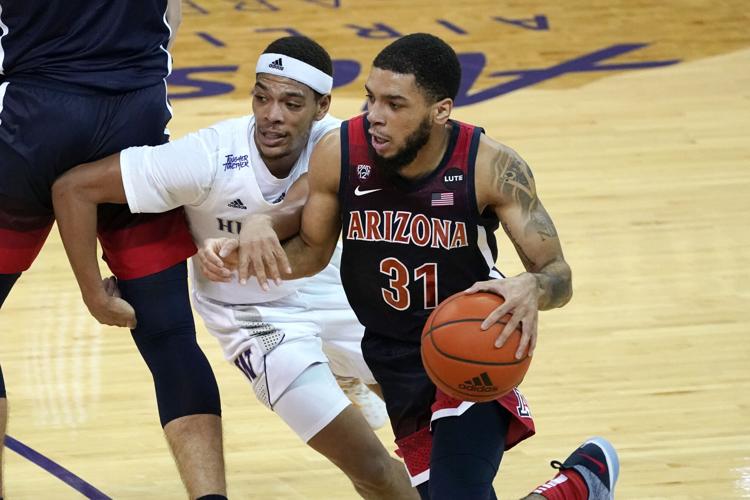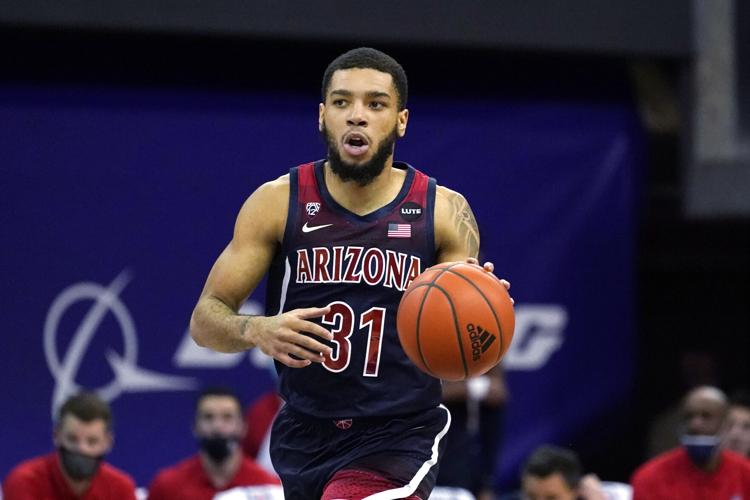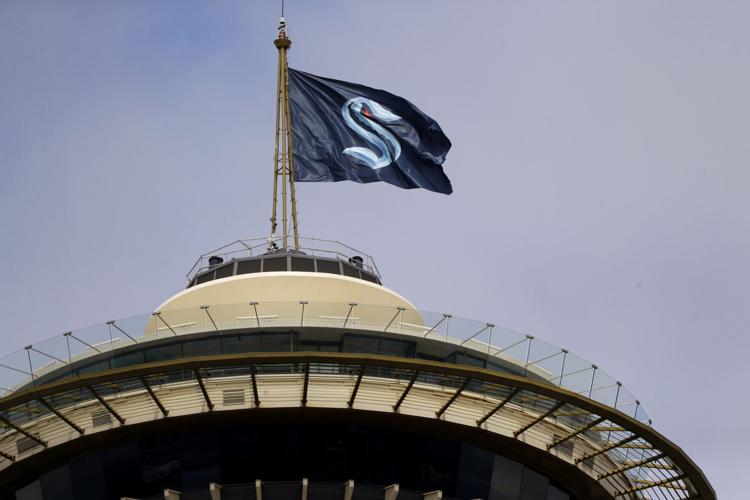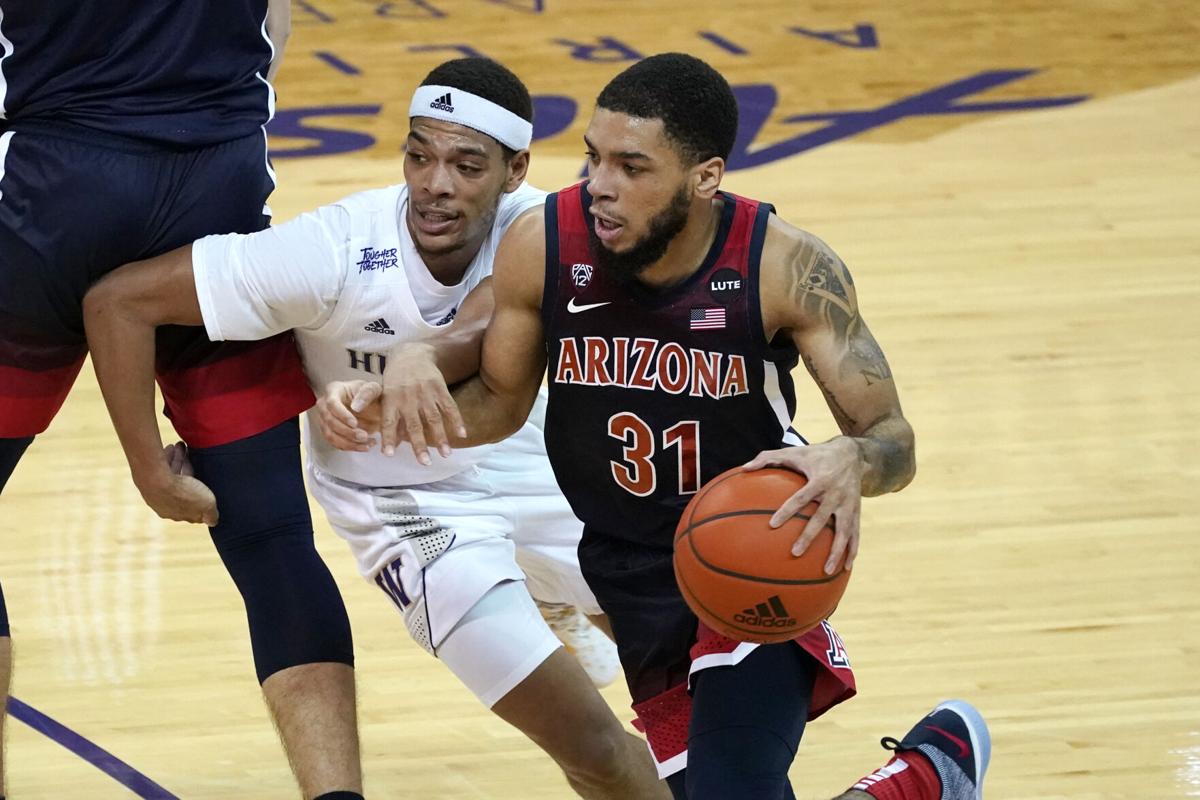SEATTLE — Seen and heard from Arizona's 80-53 win over the Washington Huskies at Alaska Airlines Arena on Thursday.
Extra COVID-friendly
In normal times, Washington’s Hec Edmundson Pavilion (also known as Alaska Airlines Arena) might be the Pac-12’s most claustrophobic atmosphere, with fans tightly packed all the way around and the student Dawg Pack section literally breathing down both team’s benches.
Of course, breathing is out of the question these days.
So with fans not allowed, Washington pulled back its foldable seating even further than many arenas. Arizona and Washington’s benches went four rows deep, allowing plenty of distance between every member of a team’s party.
Meanwhile, on the north concourse, the Huskies took advantage of suddenly unnecessary space without fans by creating a makeshift weight room with plenty of distance between stations.
In fact, one of the stations was separated by an idle Dippin’ Dots ice cream stand, while the other end featured a mobile cleaning station.
Just business

Arizona's Terrell Brown Jr. brings the ball up against Washington during the first half of an NCAA college basketball game Thursday, Dec. 31, 2020, in Seattle. (AP Photo/Elaine Thompson)
Thursday’s game marked a return home for both Arizona assistant coach Jason Terry and senior guard Terrell Brown, but they might as well have been in Kansas for all they knew.
Families aren’t allowed at games, meaning neither had anyone on hand watching them, while all players are expected to strictly limit social interaction off the court no matter where they are.
“You’re not really allowed to do that, so it’s hard,” UA coach Sean Miller said of Brown’s situation earlier this week. “It’s hard on Terrell. It’s hard on all of us, on everybody. We’re no different than you guys and we’re trying to follow the rules as best we can.”
So close and yet…
Electronic traffic boards all around Seattle flash the words “Stay safe WA. Wear a mask. Limit gatherings.”
Arizona signee Shane Nowell is following those protocols, too. His coach at Eastside Catholic in suburban Sammamish, Brent Merritt, said his team hasn’t even bee able to practice so far this season.
“Nothing going on here,” Merritt said via email.
Like just about everyone else, Nowell had to watch Thursday’s game on television, too.
‘The Kid’ brought friends
Ken Griffey Jr is among the celebs “at” tonight’s game pic.twitter.com/YDIlXAtCbY
— Bruce Pascoe (@BrucePascoe) January 1, 2021
Washington kept its cardboard fans to just two sections: Behind the west side basket are rows of Washington students, all with purple UW polo shirts on, while the east side features fans, celebrities and four different “Huskies” (real ones and mascot ones).
Among the celebrities included Seahawks quarterback Russell Wilson, actor/martial artist Bruce Lee, “Dwight” from The Office and, of course, Mariners great Ken Griffey Jr. — even though “The Kid” sent his own kids, Trey and Taryn, to the UA.
Not quite the same
Dawg Pack probably won’t be too intimidating for a change. pic.twitter.com/gDJZNBiVgl
— Bruce Pascoe (@BrucePascoe) January 1, 2021
Washington still tried to throw out some of the usual intimidation at the Wildcats. With its students limited to cardboard, the Huskies threw up a montage of fans turning the other way when Arizona’s starting lineup was introduced.
“Who cares?” it read.
Then Washington did the usual home-court video intro, entitled “Welcome to the 206,” Seattle’s primary area code.
Hair raisers
Struggling on the court in the early season, the Huskies still might lead the Pac-12 in one category: Hair.
RaeQuan Battle, Marcus Tsohonis and Nate Pryor all have big heads of hair.
So much so that Battle, the first Tulialip tribe member to earn a Division I scholarship, was even asked jokingly on Wednesday if the trio had some sort of “Hair Club” endorsement scheme going.
“Not at the moment, not really,” Battle said, chuckling. “You know, I think it just came out of nowhere. My hair grows pretty fast and Marcus has been growing for a while and Nate just showed up with his hair out. So I mean, it just all came together. We’re all bros, you know — we’ve known each other for years so I guess it’s just a friend thing.”
Both Battle and Tsohonis played for the well-regarded Seattle Rotary club team on the Nike EYBL circuit.
Last season, Tsohonis was even called a “Hair-Raising” Husky in a story that said he could have fit in with the ABA, alongside Dr. J and Artis Gilmore.
Different times, different name

A mass of lookups occurred for kraken in July after Seattle's new National Hockey League franchise chose the mythical sea monster as its name, urged along by fans. The hockey expansion franchise unveiled its nickname in July, ending 19 months of speculation about whether the team might lean traditional or go eccentric with the name for the league's 32nd team. Seattle's colors are a deep dark blue with a lighter shade of blue as a complement.
While Washington’s venerable Hec Edmundson Pavilion officially took on the Alaska Airlines Arena name in 2011 for at least $700,000 annually, Seattle neighbor Amazon put a different spin on corporate names when it bought naming rights last June to what was Key Arena.
The renovated building is now called “Climate Pledge Arena,” and will house the NHL’s new Seattle Kraken in 2020-21 along with former Key Arena tenants Seattle Storm (WNBA) and Seattle U Redhawks.
Kraken CEO Tod Leiweke told the Seattle Times that the arena aims to produce zero waste, sell locally sourced food and eliminate single-use plastics by 2024.
‘We were talking about Amazon and talked about community,” Leiweke told the Times. “And they came back and said, ‘Look, the No. 1 community cause for us and what we believe in most is climate and Jeff’s commitment to the Climate Pledge.’ And we came away inspired.”
Of course the “Jeff” referred to is Amazon CEO Jeff Bezos, who pledged $10 billion to fight climate change in February.
Help for Pike Place
Almost seems like business as usual at Pike Place Market. pic.twitter.com/jnPxB8JCyq
— Bruce Pascoe (@BrucePascoe) December 31, 2020
While things are a bit quieter in downtown Seattle these days with tourists generally gone and office workers largely at home, Pike Place Market still featured nearly the usual winter time crowds strolling its farmers market section Thursday.
But, as with nearly everything, life has been hardly normal for the city’s famed market, which said more than 450 businesses were forced to close initially after the coronavirus hit, forcing significant financial damage.
In an effort to help, the Pike Place Market Foundation set a goal of generating $3.5 million in donations to a three-pronged “Power of Pike Place Recovery Campaign” – with one arm to help its small businesses, another for those who work or live in its community he market community and nearby social services such as a medical clinic, food bank, senior housing and a preschool.







